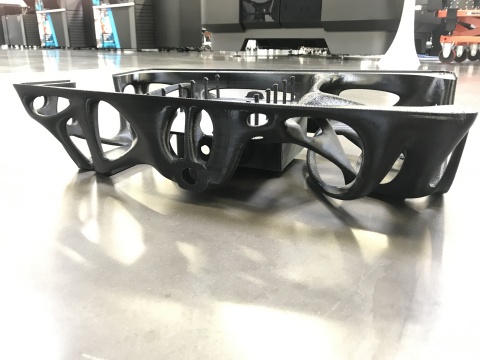Developing the design workflow for one-off products, students in Germany have 3D printed a self-balancing scooter using Stratasys machines.
A Stratasys news release has given us a peek at one of the innovations to display at formnext this month. A 3D printed scooter, the piece is special for a couple of reasons.
Firstly, it is self-balancing. That’s pretty special, and though Segway has been there and done that, this 3D printed specimen has something over the tour-guide wheels of choice: it is a “first of its kind” one-off product conceived to benefit from digital development integrating 3D printing.
It was created by students from the University of Applied Sciences Ravensburg-Weingarten, Germany. As part of a larger industry-wide initiative to pioneer digital workflows for creating one-off and custom products, the students explored solutions to the limitations imposed when using traditional manufacturing methods.
Stratasys reveals in the release that the students quickly learned to “think additively”. And the results are stark. The first fully-functional prototype was ready in a fraction of the time that would be needed using traditional manufacturing methods. The study reports the time savings as 85% over creation using traditional manufacturing methods.
“We realized that 3D printing offers the best possible manufacturing solution for an ideal executable product development method for a customized product,” said Dr.-Ing. Markus Till, head of the university’s Department of Mechanical Engineering.

A Balancing Act
After identifying additive manufacturing as the key area in which the prototyping could be accelerated, the team shaped their development process around the Stratasys machines available to them.
“We designed the entire product development process around Stratasys’ additive technologies, enabling us to quickly design and produce a fully-functional prototype of a geometry that was previously too complex to be created through any other traditional method” continues Till.
The students used tough Nylon6 material for many of the scooter’s parts. Using a large-scale Stratasys Fortus 900mc Production 3D Printer, it was possible to print the larger pieces whole. Additional grip for the rider is given through a skin-like part printed in Agilus30 material on the Stratasys Connex3 Color Multi-material 3D Printer.
“Using traditional manufacturing processes such as milling or molding, the most notable challenge is developing the scooter’s body frame, which houses several parts from motor to electrics. Firstly, the structure of the part is too complex for subtractive methods, while the turnaround times are too time-intensive to meet the production schedule.” Till explains.
He continues: “As a result, we’ve seen students start to ‘think additively’, leveraging the capabilities of the 3D printing to design with more freedom and with customization in mind“.
If you want to get up close to the self-balancing scooter yourself, it will be on display at formnext in Frankfurt. Check it out between November 14th and 17th in Hall 3.1, Stand F40.
Following the success of the project, Till adds that the 3D printing technology is subject to great demand in the curriculum. With industry partners keen to see future generations of graduate savvy in additive manufacturing methodology the university is extending its usage to more engineering projects.
Source: Business Wire

License: The text of "Students Use Stratasys 3D Printers to Develop One-Off Self-Balancing Scooter" by All3DP is licensed under a Creative Commons Attribution 4.0 International License.